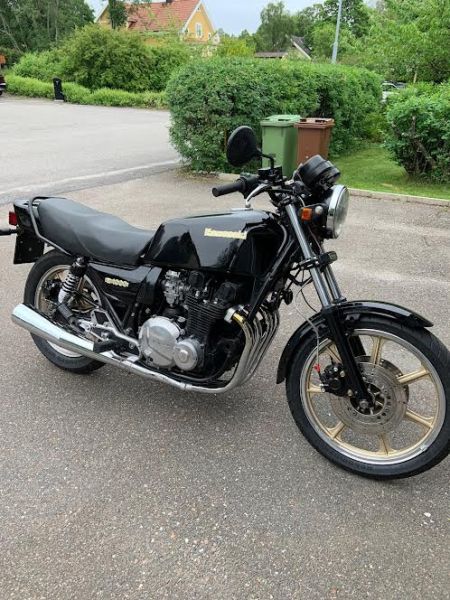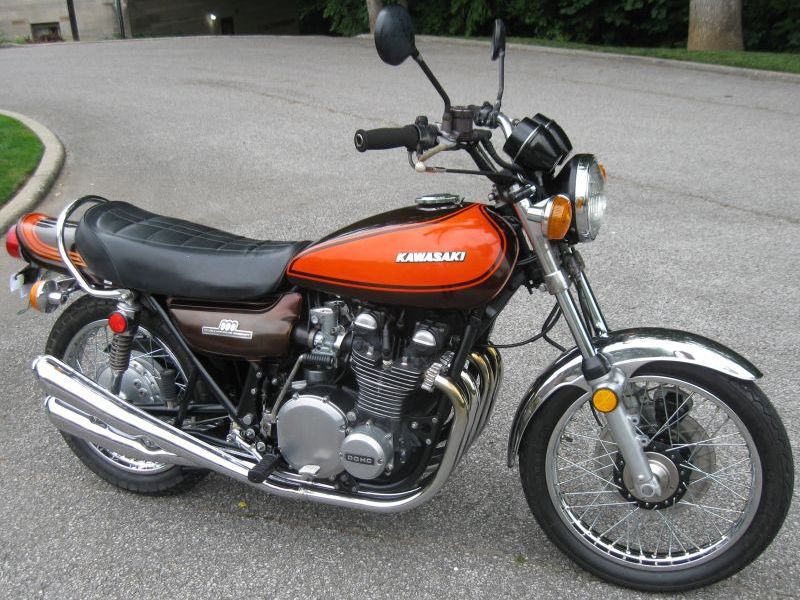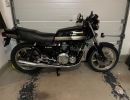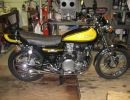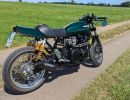I think this might help...
KZ650 Slide Carburetor Tuning
The following information is based on the carburettor set up procedure suggested by Dynojet
for the Mikuni Slide carburettor used on the KZ range.
Kawasaki models fitted with the air injection system that are converted to individual air filters
should have the large hose that goes into the top side of the air box for the air injection system
sealed, or routed in a loop from one side to the other. If you wish to keep a functional air
injection system, you may do so by attaching a crankcase breather filter to the end of the hose
that vent into the air box. A functional injection system will produce additional noise that you
may find annoying.
Ensure that:
The carburettors have been cleaned and that all jets and jet pathways are clear and not obstructed by debris, foreign material or fuel varnish / residual.
1.The float height has been checked and adjusted to factory specifications
2.The air cleaner filter is clean and not obstructed or blocked.
3.The rubber intake manifolds between the carburettor bodies and the cylinder block have
no vacuum leaks caused by cracks or holes in the rubber
4.Initial Carburettor Mechanical Synchronization
The following procedure shows how to mechanically synchronize carburettors so that a proper
idle can be attained.
Remove the carburettors from the engine.
1.Remove all top covers from the carburettors and loosen the throttle arm locknut.
2.Turn the throttle arm adjusting screw to allow for a slight clearance between the carburettor bore and the bottom of the slide.
3.Insert a piece of wire 0.8 – l.0 mm in diameter between the bottom of the slide and the
carburettor bore.
4.Turn the throttle arm adjusting screw until the wire can just be moved in and out without noticeable friction or drag. i.e.. not too tight (drag) and not too loose (slop).
5.Tighten the throttle arm adjusting screw locknut without changing the adjustment and replace the top cover. NOTE: All 4 carburettors must be adjusted exactly the same, so do this procedure carefully and correctly.
6.With the carburettors fully assembled on the bench take a minute to double check your work. Check for missing screws, slide action, throttle plate function, in general anything out of the ordinary.
7.Now install the carburettor assembly in reverse order of its disassembly
8.2 of 6 20/10/2005 3:24 PM
Install your specific style of air filter according to the manufactures instructions.
9.Replace the fuel tank, side covers, and seat,
10.Turn the fuel valve on and check for leaks while the float bowls are filling.
11.Start the engine, turn the handle bars from side to side to insure that the cables are not binding and cause the engine to race. Blip the throttle a couple of times to insure the linkage is not sticking.
12.If the specialised equipment is available, conduct a Carburettor Fine Synchronization, if not
proceed to Section One – Air Mixture Screw Adjustment.
WARNING – Double check all, vacuum lines, fuel lines, throttle cables, choke cables, clamps, mounting bolts, hose and wire routing and any other part that has been removed of adjusted during installation Do not drive the motorcycle if set up does not check out perfectly.
Carburettor Fine Synchronization
Prior to this fine synchronization, the ignition timing, valve clearance, and idle speed must be
correct. This procedure requires a special tool to measure the manifold vacuum for all four cylinders simultaneously.
Start the engine and let it reach normal operating temperature.
1.Shut off the engine and remove the rubber caps from the four vacuum line test points on the intake manifolds.
2.Connect the vacuum lines from the synchronizing tool, following the manufacturer's instructions, to the test points on the manifolds.
3.Start the engine and observe the mercury level. The difference between any two cylinders should be less than 2 cm of mercury.
4.If the difference is greater than 2 cm of mercury, proceed as follows.
Shut off the engine.
1.Remove the fuel tank and either connect a temporary fuel supply or place the bike’s fuel tank on secure stand/bench and connect a temporary fuel line from the fuel tank to the carburettors. Switch the fuel tap to the “PRI” position.
2.Clamp or block off the vacuum hose from carburettor #2 that normally runs to the fuel tank.
3.WARNING – A temporary or remote fuel supply is potentially a real fire danger. Ensure that all
tanks are secure and the all fuel lines are routed so that they do not come into contact with a hot exhaust pipe. Remove the top covers from all carburettors and loosen the throttle arm locknuts.
4.Start the engine and let it run at idle speed (950 -1050 rpm).
5.3 of 6 20/10/2005 3:24 PM
Readjust each throttle adjusting screw until all carburettors are within 2 cm of mercury of each other. NOTE: Backing out the screw decreases vacuum and turning it in increases vacuum.
6.Once fine synchronisation is complete. Shut the engine off and refit the fuel tank back onto the bike and reconnect the vacuum hoe and the fuel line to the tank.
7.WARNING – Double check all, vacuum lines, fuel lines, throttle cables, choke cables, clamps,
mounting bolts, hose and wire routing and any other part that has been removed of adjusted during installation Do not drive the motorcycle if set up does not check out perfectly.
SECTION ONE – AIR MIXTURE SCREW ADJUSTMENT
The air mixture screws control air. They are used in conjunction with all of the carburettor's other jets to allow a means to compensate for differences in seasonal temperature and geographical locations. Turning the screws out increases air giving leaner mixtures at idle and in the cruising mode. This can be useful when operating in hot weather or high altitudes.
Turning the screws in restricts air flow giving richer mixtures which can improve cold weather
operation. Adjusting the mixture screws at regular intervals will help maintain a high degree of
driveability.
Warm the engine up to normal operating temperature. If the engine fails to idle, the problem will be either lack of fuel, or debris in the pilot system or carburettor synchronisation. Make sure the engine will idle smoothly before going any farther with the
adjustment procedure.
1.Gently screw the air mixture screw in (clockwise) until the just touch the bottom.
CAUTION: Excess force while seating the air mixture screw can damage the carburettor
beyond repair.
2.Initially screw the air screw out(counter-clockwise) 2 complete turns.
3.Adjust the mixture screws within 1 complete turn either way of the base setting to attain the smoothest idle.
4.Reset idle to factory specifications. ( 950 – 1050 rpm )
5.At this time blip the throttle to rev the engine up quickly to 5000 – 6000 rpm, while in neutral. The engine should be responsive to the throttle. If the engine fails to respond normally, check to see that the engine is getting sufficient fuel.
Note: If there is in-sufficient fuel, check the order in which you installed the needles and the E-clips. If the parts are installed correctly move the E-clip to the next richer groove position on the needle. For example, if the factory setting was groove 3, moving the E-clip to groove 4 will make it richer. (the groves are numbered with groove 1 closest to the blunt end of the needle.)
Repeat steps 2 thru 4 until the engine responds to throttle properly.
SECTION TWO – INITIAL TEST DRIVE
The initial test drive consists of three specific tests. Due to the complex nature of the motorcycle
carburettors, perform the tests in the exact manner as they are given in this section. This is very
important if you should have trouble requiring outside technical assistance. You will be asked
specifically for the results of the tests in section two.
WARNING - With the engine running, turn the handle bars from side to side to insure that the cables are not binding and cause the engine to race. Blip the throttle a couple of times to insure the linkage is not sticking. Also check the function of the clutch and kill switch to insure that cables or wires have not become improperly routed or damaged. Under no circumstance should your motorcycle be driven if the preceding function checks did not check out perfectly.
SECT TWO - TEST ONE - LEAN CRUISE TEST
Test drive the motorcycle in first gear (do not change gears) and slowly accelerate from idle to 2000 rpm. Maintain that speed for at least 15 seconds, then increase the speed to 3000 rpm, and hold it there for another 15 seconds. Continue accelerating and holding steady at every thousand rpm until you reach 50% of the full rpm range i.e. for a motorcycle with a 10,000 rpm red line you run the tests to 5000 rpm. During the cruise portion of these tests pay close attention to the engines power delivery.
1.If there is a slight surging or hesitation, during the cruise portions, this is an indication that the engine is running slightly lean when the carburettors are functioning in their leanest operating mode. To correct this turn all the air mixture screws in ¼ to ½ turn, from the position arrived at during the air mixture screw adjusting procedure above. Now repeat the lean cruise test again until the surging is gone.
2.Note: If during steps 1 & 2 above you find that the fuel mixture screws are turned in 1 to 2 turns past the settings arrived at in the air mixture screw adjustment procedures, without having much affect on the surge, or if it stops the surge but causes the engine to idle poorly, the lean problem may be out of the range of the mixture screws and will probably require a needle adjustment. In this case return the fuel mixture screws back to the settings arrived at during the fuel mixture screw adjustment procedures and go to Test Two - Moderate Acceleration Lean Test.
SECT TWO - TEST TWO – MODERATE ACCELERATION LEAN TEST
While driving the motorcycle in first gear at 2000 rpm, accelerate at no less than ½ throttle and no more than ¾ throttles to 50% of your rpm band (as explained in Test One above).
Note: Do not test any higher than the 50% mark.
1.Once you reach this de-accelerate back down to 2000 rpm. Repeat this process about 5 times to make sure that any excess oil from the freshly installed air filters is not effecting the carburetion. If after the fifth run you notice any type of carburetion problem the most probable cause under these test conditions is leanness.
2.To correct this problem move the E-clips on the needles to the next richer position. (i.e. if ongroove 3 then move to groove 4).
5 of 6 20/10/2005 3:24 PM
Note: Before making any adjustment to the E-clip settings make sure you check the order in which you installed the needles and any of the required springs, washers, or spacers, against the installation instructions. If an error is noticed in the assembly order then correct it and repeat the Section Two tests from the beginning.
Note: As the throttle arm needs to be loosened in order to remove the needles, it is necessary to re-balance the carburettors after each needle adjustment.
Note: Because the air mixture screws control air bleed to all fuel circuits, air mixture screw
adjustment should be done again at each different needle setting.
SECT THREE - TEST THREE – ACCELERATION MODE – RICH TEST
While driving the machine at 2000 rpm in first gear accelerate at full throttle to red line. Do this acceleration two or three times. If you have carburetion problems in the mid to upper portions of the rev range under these conditions, the most probable cause is a rich mixture. This assumption would be further strengthened if you went through Tests One and Two without having to make any adjustments.
1.To correct this problem you should move the E-clip to the next leaner position on the needles.
(i.e. if the E-clip was on groove 3, then move the e-clip to groove 2. The groves are numbers
downwards with grove 1 closest to the blunt end of the needle).
Repeat both tests two and three until you have a setting that passes both tests.
Double check the results of test three by driving the machine in the same manner as step one but this time in second gear.
2.At this point your machine should pass Tests One, Two and Three. If you wish you may call your installation complete. Note: an extra measure of performance may be obtained by adjustments found in Section Three.
3.SECT TWO - TEST THREE FAILURE
If at this point your machine passes Test One and Test Two but can not pass Test Three, your machine may be running at less then designed efficiency. Some probable causes are poor overall state of tune, poorly designed aftermarket exhausts, defective exhausts caused by high mileage, plugged or non-existent baffling, dented pipes or mufflers, dirty or otherwise defective air filters. Under these circumstances it is better to fix the problem cause than to try and adjust to overcome the defects.
If you can not correct the efficiency loss, you may try to decrease the fuel delivery rate to match the machines present state of tune. To do this reduce the main jet size by replacing the Main jets with jets which are 5 jet sizes smaller (i.e. 120 Main jets down to 115 Main jets) then repeat Test Two and Test Three.
6 of 6 20/10/2005 3:24 PM
SECTION THREE – ADJUSTING FOR MAXIMUM PERFORMANCE
In Section Two you did three tests. Tests One and Two checked to make sure your machine did not run too lean. Test Three checked to make sure your machine didn't run too rich. Typically the Japanese motorcycles produced in recent years can function with minor modifications without any noticeable flaws at air/fuel ratios ranging from 14:1 to 11:1. Adjustments in carburettor jetting that fall at either end of this range are referred to as “fringe jetting”. Fringe jetting is responsible for the common myth that performance jetting must constantly be altered for normal temperature or differences in altitude. If a machine is operating in the rich fringe jetting range, for example at a air/fuel ratio about 11:1 at sea level at 70 degrees, it is likely that a difference of 2500 feet elevation and a +20 degrees could change the air/fuel ratio to perhaps
10.5:1 thus causing a slight carburetion problem during hard acceleration. The same thing can happen on the other end of the scale although it is not as common.
You can use the following procedure to make sure your bike is not jetted in the rich fringe area.
SECT THREE - NEEDLE ADJUSTMENT
Make sure you have adjusted your machine so it passes Test One, Two and Three.
1.Adjust the E-clip to the next leaner position (i.e. if in groove 3, move to grove 2).
2.Place a small thin washer, approximately 6mm OD, 3mm ID and 0.5mm thick under the E-clip and reassemble the needle back into the carburettor slide. The washer has the effect of simulating a ½ half slot step.
3.Once this adjustment is made repeat Test One and Test Two of the Initial Test Drive.
4.If this new needle setting passes Test Two without any adjustments then repeat steps 2 and 3
of this procedure until you fail to pass Test Two of the Initial Test Drive.
Once you have reached a setting that will not pass Test Two, move the needle back ½ steps (richer) to the position that previously passed Test Two, of the Initial Test Drive.
SECT THREE - MAIN JET ADJUSTMENT
If your machine passed all Tests One, Two and Three and you passed the Needle Adjustmen tests in Section Three, but have a slight loss of peak power in the upper gears OR you have a white exhaust pipe after prolonged high speed use, replace the main jets 2.5 to 5 jet sizes bigger. (i.e. 100 Main jets are replaced with 102.5 or 105 Main jets)
 Jonas' Z1000 BOTM July '24
Jonas' Z1000 BOTM July '24 Slmjim+BEBE's '73 Z1 BOTM May '24
Slmjim+BEBE's '73 Z1 BOTM May '24
















